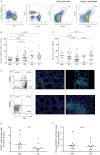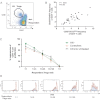Preserved function of regulatory T cells in chronic HIV-1 infection despite decreased numbers in blood and tissue
- PMID: 22427677
- PMCID: PMC3415814
- DOI: 10.1093/infdis/jis236
Preserved function of regulatory T cells in chronic HIV-1 infection despite decreased numbers in blood and tissue
Abstract
Regulatory T cells (Tregs) are potent immune modulators, but their role in human immunodeficiency virus type 1 (HIV-1) pathogenesis remains poorly understood. We performed a detailed analysis of the frequency and function of Tregs in a large cohort of HIV-1-infected individuals and HIV-1 negative controls. While HIV "elite controllers" and uninfected individuals had similar Treg numbers and frequencies, the absolute numbers of Tregs declined in blood and gut-associated lymphoid tissue in patients with chronic progressive HIV-1 infection. Despite quantitative changes in Tregs, HIV-1 infection was not associated with an impairment of ex vivo suppressive function of flow-sorted Tregs in both HIV controllers and untreated chronic progressors.
Figures


Comment in
-
Regulatory T cells in HIV-1 infection: the good, the bad, and the ugly.J Infect Dis. 2012 May 15;205(10):1479-82. doi: 10.1093/infdis/jis238. Epub 2012 Mar 28. J Infect Dis. 2012. PMID: 22457283 No abstract available.
References
Publication types
MeSH terms
Substances
Grants and funding
LinkOut - more resources
Full Text Sources
Medical

